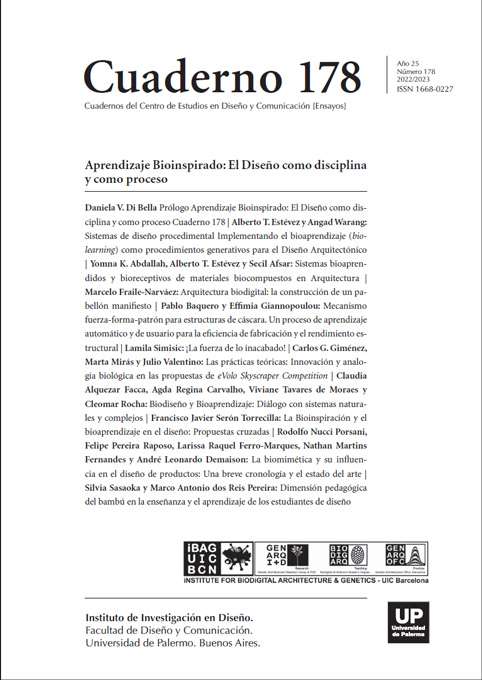Mecanismo fuerza-forma-patrón para estructuras de cáscara
Abstract
The geometric characteristics of animal skin patterns and their biological mechanism inspire the consideration of their structural efficiency as a foundation for construction, providing a scientific framework for more sustainable architectural applications.
References
Bernal, M. (2016). “From Parametric to Meta Modelling in Design”. En VV.AA. SIGraDi 2016, XX Congreso de la Sociedad Iberoamericana de Gráfica Digital. Buenos Aires: SIGraDi, pp. 579-583.
Camazine, S. et al. (2003). Self-organization in Biological Systems, Princeton: Princeton University Press, p. 91.
Cazzaro, I. (2019). ICGG 2018 - Proceedings of the 18th International Conference on Geometry and Graphics. Milán: ICGG.
Fornes, M. (2016). “The Art of the Prototypical”. Architectural Design, 86 (2), pp. 60-67.
Giannopoulou, E., Baquero, P., Warang, A., Estévez, A.T. (2021). “Machine learning approach for biological pattern based shell structures”. En S. Bartolo et al. (eds.), Industry 4.0 - Shaping the Future of the Digital World, Boca Raton / Londres: CRC Press / Taylor & Francis, pp. 79-83.
Giannopoulou, E., Baquero, P., Warang, A., Orciuoli, A., Estévez, A.T., Brun-Usan, M.A. (2019a). “Biological pattern based on reaction-diffusion mechanism employed as fabrication strategy for a shell structure”. IOP Conference Series: Materials Science and Engineering, 471 (9). IOP Publishing Ltd.
Giannopoulou, E., Baquero, P., Warang, A., Orciuoli, A., Estévez, A.T., Brun-Usan, M.A. (2019b). “Employing mesh segmentation algorithms as fabrication strategies: Pattern generation based on reaction-diffusion mechanism”. FME Transactions, 47 (2). Belgrado: University of Belgrade, Faculty of Mechanical Engineering, pp. 379-386.
Giannopoulou, E., Baquero, P., Warang, A., Estévez, A.T. (2019c). “Stripe Segmentation for Branching Shell Structures - A Data Set Development as a Learning Process for Fabrication Efficiency and Structural Performance”. En J. P. Sousa, et al. (eds.), Architecture in the Age of the 4th Industrial Revolution: Proceedings of the eCAADe + SIGraDi joint Conference 2019. Oporto: eCAADe / SIGraDi.
Giannopoulou, E., Baquero, P., Warang, A., Estévez, A.T. (2019d). “Computational Workflow for Segmented Shell Structures: an ANN Approach for Fabrication Efficiency” En C. Lázaro, et al. (eds.), Structural Membranes 2019 FORM and FORCE, Barcelona: International Centre for Numerical Methods in Engineering (CIMNE), pp. 2598-2605.
Koch, A.J., Meinhardt, H. (1994). “Biological pattern formation: From basic mechanisms to complex structures”. Rev. Mod. Phys. 66 (1481).
Kondo, S., Miura, T. (2010). “Reaction-diffusion model as a framework for understanding biological pattern formation”. Science, 329 (5999), pp. 1616-1620.
Kondo, S. (2002). “The reaction-diffusion system: A mechanism for autonomous pattern formation in the animal skin”. Genes to Cells, 7, pp. 535-541.
Lin, H., Wooley, J. (2005). Computational Modeling and Simulation as Enablers for Biological Discovery. Catalyzing inquiry at the interface of computing and biology. Committee on Frontiers at the Interface of Computing and Biology, National Research Council.
Nejur, A., Steinfeld, K. (2016). “Ivy- Bringing a Weighted-Mesh Representation to Bear on Generative Architectural Design Applications”. En Proceedings of 36th ACADIA. Posthuman Frontiers: Data, Designers, and Cognitive Machines. Ann Arbor: ACADIA, pp. 140-151.
Nejur, A., Steinfeld, K. (2017). “Ivy Progress in Developing Practical Applications for a Weighted-Mesh Representation for Use in Generative Architectural Design”. ACADIA 2017 37th Annual Conference of the Association for Computer Aided Design in Architecture. ACADIA, pp. 446-455.
Piker, D. (2013). “Kangaroo: Form finding with computational physics”. Architectural Design, 83 (1), pp. 136-137.
Stach, E. (2010). “Structural morphology and self-organization”. Journal of the International Association for Shell and Spatial Structures, 51 (165), pp. 217-231.
Sennett, R. (2009). The Craftsman, Yale University Press.
Spuybroek, L. (2006). The sympathy of things: Ruskin and the ecology of design. Londres: Bloomsbury, p. 100.
Tamke, M., Thomsen, M.R. (2018). “Complex Modelling”. International Journal of Architectural Computing, 16 (2), pp. 87-90.
Tamke, M., et al. (2017). Lace Wall: Extending Design Intuition Through Machine Learning. Fabricate. Londres: UCL Press.
Tamke, M., Nicholas, P., Zwierzycki, M. (2018). “Machine learning for architectural design: Practices and infrastructure”. International Journal of Architectural Computing, 16 (2), pp. 123-143.
Turing, A.M. (1953). “The chemical basis of morphogenesis”. Philosophical Transactions of the Royal Society B: Biological Sciences, 237, pp. 37-72.
Weinstock, M. (2004). “Emergence: Morphogenetic Design Strategies”. AD, 74 (3). Londres: Wiley-Academy, p. 17.
Wolfram, S. (2002). A new kind of science. Champaign: Wolfram Media, p. 862.
Los autores/as que publiquen en esta revista ceden los derechos de autor y de publicación a "Cuadernos del Centro de Estudios de Diseño y Comunicación", Aceptando el registro de su trabajo bajo una licencia de atribución de Creative Commons, que permite a terceros utilizar lo publicado siempre que de el crédito pertinente a los autores y a esta revista.


